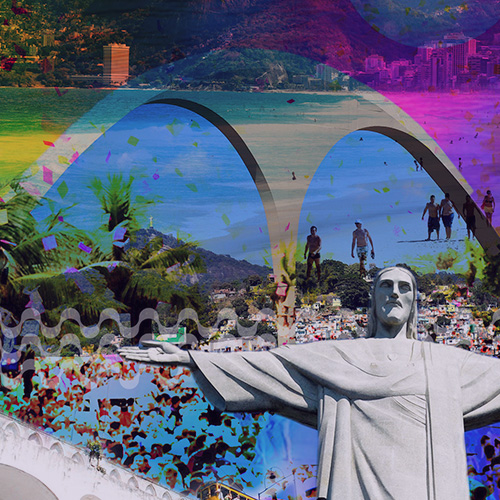Don´t forget to see, live and feel
Here, some of the highlights, known and famous tourist points which are ideal for your visit in the Marvelous City. Places that represent the city by itself and make Rio de Janeiro, an incredible, full of experiences that you will find only here and also rediscover, always with some novelty and a new point to be included. There is only one motto: to enjoy!

Corcovado – Cristo Redentor
Christ the redeemer
Rua Cosme Velho, 513 – Cosme Velho – (+55 21) 2558-1329 / 2492-2252 / 2492-2253 – tremdocorcovado.rio / paineirascorcovado.com.br / santuariocristoredentor.com.br
An Icon of the city, Christ the Redeemer salutes and blesses the visitors who arrive in Rio de Janeiro. From the top of its 38 meters – and the 710 meters of Corcovado Mountain – the Christ, with open arms, is the image of faith and sympathy of carioca people.To get to the statue, you will make an agreeable tour with the train crossing the Atlantic Forest, leaving from the district of Cosme Velho, and a service of accredited vans leaving from Largo do Machado and Praça do Lido walk along the Paineiras Road.
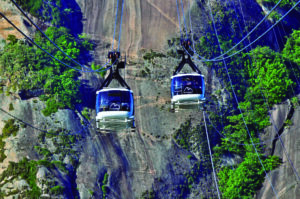
Pão de Açúcar
Av. Pasteur, 520 – Urca, Rio de Janeiro
Opening hours: 8h30 às 20h00. Último embarque às 18h30.
Tickets on site: https://bondinho.com.br/ / @parquebondinho
From the cable car ride tol Urca Mountain and Sugar Loaf, unveiling the cove of Botafogo, Copacabana waterfront and the entrance of Guanabara Bay. The Sugar Loaf mountain is 395 meters above sea level, and reveals other angles of the city, like Gávea Rock, downtown Rio, Corcovado and Christ the Redeemer. To enjoy the tour, there are options of gastronomy and entertainment, and Urca Hill has a large amphitheater much used for shows and events, combining fun to marvelous view of lights of the city.
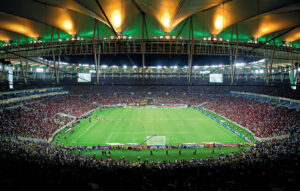
Maracanã
Avenida Pelé s/n – Gate 2
Tickets: on site www.ingressocerto.com/maracanatour or the ticket office. Guided tour: R$ 60( half R$ 30), Self guided tour:R$ 50( half R$ 25) / @maracana
Maracanã stadium was once the scene of the most important Brazilian football classics, and welcomed historical moments of the international scene. The Grand final stage of the 2014 Cup, it is open daily for visits. During the tour the visitors may know the stands, the cabins stall, visit the changing rooms and end the tour very close to the most famous lawn of Brazilian football.
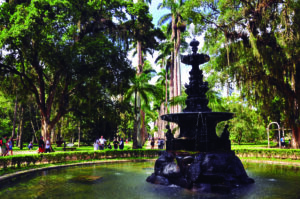
Botanical Gardens
Rua Jardim Botânico, 1008 – Jardim Botânico Segunda a domingo, das 8h às 17h
Tickets on site: https://jbrj.eleventickets.com/#!/home/ @jardimbotanciorj
Founded in 1808 by D. João, the Botanical Gardens are famous for its exuberance and importance of its collection of plants, as well for the beauty of the landscapes. Its bicentennial history is expressed in the monuments, constructions and works of art. Visitors can walk or go by electric car through the alleys and observe plants from several countries, discover the greenhouses, gardens and the thematic collections, as the Japanese Garden. The Garden is also a good place for bird´s watching.

Parque Lage
Rua Jardim Botânico, 414 – Jardim Botânico
http://eavparquelage.rj.gov.br / @parquelage
At the foot of Corcovado mountain, Park Lage is enchanting with its 52 hectares of pure green, cultural programs and art. In the first building of the space, a big house of the 19th century, the Visual Arts School, with free training for artists, art courses for young people, besides an intense program of exhibitions, lectures and workshops. In the central courtyard, by the pool, Bistrô Plage offers a delicious breakfast, lunch and dinner with organic products. Golden tip: it´s the favorite point of cariocas in love.Take your partner!

Arches of Lapa and Selarón Staircase
Lapa dand Rua Manuel Carneiro – Santa Teresa
It is the district of Lapa, the most bohemian of Rio, with its Arches, that became one of the most famous postcards of the city – and a symbol of Old Rio. In this region, there are a variety of bars and restaurants, with diversified menus and a “touch” of carioca style. Also in Lapa, we find Selarón Staircase, one of the most beautiful in the world. made of tiles, it takes the name of its creator, artist Jorge Selarón, and nowadays gathers visitors from around the world to take pictures of a little bit of Brazil and Rio.

Museum of Tomorrow
Praça Mauá, 1 – Centro
https://museudoamanha.org.br / @museudoamanha
The Spanish architect Santiago Calatrava designed the Museum of Tomorrow, which was inaugurated in 2015.Its installations cover an area of approximately 30.000 m2 with gardens, water mirrors, a cycle road and leisure areas. Its theme is oriented to the promotion of innovation, promote the progress of science and exalt the vital signs of the planet. It is worth highlighting that the institution was awarded the title” Leading Culture Destinations Awards”, in the category of best Museum of the Year of South and Central America.
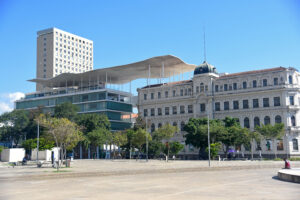
Museum of Art of Rio
Praça Mauá – Centro – tel. 3031-2741
museudeartedorio.org.br/ @museudeartedorio
Inaugurated on the first of March of 2013, Museum of Art of Rio – MAR presents a program of exhibits and shows with historical content. The space consists of an area of two buildings linked by a slab supported by pilotis. The little Palace Dom João VI, in an eclectic and heritage style, houses the exhibition rooms. The neighboring building, originally the Bus Terminal, nowadays is the Escola do Olhar, whose mission is to promote art in public education.
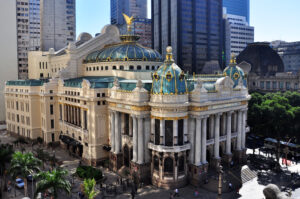
Municipal Theatre of Rio de Janeiro
Praça Floriano, s/n Theatro Municipal – Centro
http://theatromunicipal.rj.gov.br/ @theatromunicipalrj
The Municipal Theater, inaugurated in 1909, is one of the main show houses of Brazil and Latin America, where great national and international artists have performed, always important names of Brazilian Culture. The stage of the temple of art, with dance,music, opera and performing arts, was created by Francisco de Oliveira Passos and the French Albert Guilbert, who were inspired by the Paris Opera House. Always concerned to maintain its own artistic Corps, it is the only Brazilian cultural institution to keep simultaneously a choir,a symphonic orchestra and a ballet company.
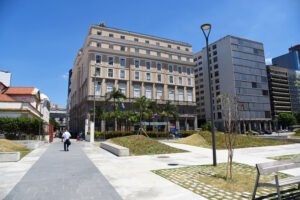
Centro Cultural Banco do Brasil
Rua Primeiro de Março, 66 – Centro
Located between buildings of neoclassical style that in the past were linked to finance and business, CCBB Rio was born, created in 1989. CCBB, a symbol of revitalization of the historical center of the city and the appreciation of culture and art, is one of the most important cultural centers of the circuit. Its program prioritizes its multiple expressions, plastic, scenic, audiovisual and musical, therefore, it is one of the most visited cultural institutions of Brazil and the world.
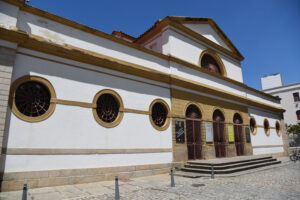
Casa França Brasil
Rua Visconde de Itaboraí, 78 – Centro
casafrancabrasil.rj.gov.br / @casafrancabrasiloficial
International renowned exhibitions make part of its multicultural program catalog. Built in neoclassic style, it was designed by the architect of the French Artistic Mission, Grandjean de Montigny, the building was inaugurated in 1820 to operate as a shopping plaza and afterwards as The Customs. In 1990, Casa França Brasil was inaugurated, assuming a pride of place and a reference in contemporary arts and culture.
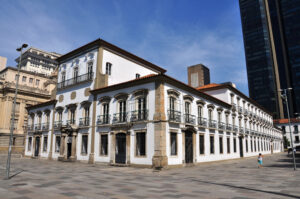
Paço Imperial
Praça Quinze de Novembro, 48 – tel. 22152093
amigosdopacoimperial.org.br/ @pacoimperial _ rj
The old residence of the Governor and Vice King of Brazil in the 18th Century, Paço Imperial was the stage of important events of our History. Among them, the famous Dia do Fico, the Abolition of Slavery and the Proclamation of the Independence of Brazil. Nowadays it houses a multicultural space with plastic arts exhibitions and a musical program linked to the National Artistic and Cultural Heritage, of the Ministry of Culture, with free entry all year round.
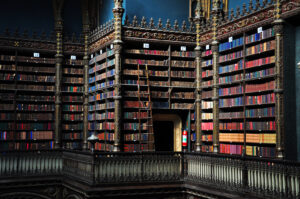
Real Gabinete Portugues de Leitura
Rua Luís de Camões , 30 – tel 2231 3138
The Portuguese Royal Reading Cabinet was founded in May 1897 with the purpose of promoting the access of Portuguese living in Rio to the access of publications of their country. Its library offers more than 350 thousand titles of Portuguese authors for free consultation to the public.

Museum of Pontal
Av. Célia Ribeiro da Silva Mendes – Barra da Tijuca 3300 – tel 24902429
museudopontal.org.br/ @museudopontal
It is considered the largest and most significant museum of popular arts of the country, with great artists of the Northeast region. The collection is composed of nine thousand pieces produced by around 300 Brazilian artists – many of them, from the northeastern region from the XX century, result of the research and trips through Brazil, made by French designer Jacques Van de Beuque. The headquarters has a view from Gávea Rock to Sugar Loaf, on consolidated land, flood free, welcoming its visitors in a pleasant way.
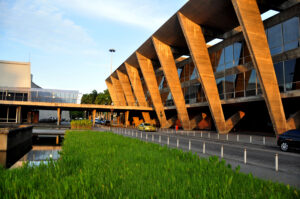
Museum of Modern Art
Av.Infante Dom Henrique, 85 – Parque do Flamengo – tel 38835600
Considered one of the most important cultural and artistic institutions of Brazil, the Museum of Modern Art, popularly known as MAM, was designed by Affonso Reidy de Souza in 1958. Its collection brings together works of national and international famous artists, modern and contemporary, including paintings, photographs, sculptures and drawings, highlighting it as a reference throughout Latin America.

National Historical Museum
Praça Marechal Âncora, s/n – Centro
Free entrance: tickets a the ticket office
https://mhn.museus.gov.br/ / @museuhistoriconacional
The National Historical Museum with an important architectural complex in downtown Rio, the National Historical Museum became one of the most important museums of the country. Gathering a collection of more than 300 thousand archival, bibliographic and museological items, is a federal institution of production and dissemination of knowledge that presents a collection of long term and temporary exhibitions, souvenir shop and publications, besides a specialized library in the History of Brazil, Art History, Museology and Fashion.

Museu Flamengo | Flamengo Museum
Av. Borges de Medeiros, 997 – Lagoa
(+55 21) 2159-0100 – museuflamengo.com / @museuflamengo
One of the most traditional clubs of Rio de Janeiro and Brazil, Flamengo invites the public to live part of the memories and great achievements of the red and black teams. From football to basketball, all modalities are included, on a real time travel that produces unique emotion to the lovers of this expressive brand of Brazilian Culture. Over fourteen thematic sections, with immersive experience and interactive attractions, the visit to the space, is on “another level.”

Yup Star
Av. Rodrigues Alves, 455 – Santo Cristo
Tickets: range from 40$ to 80$.
Shopping via website
https://loja.multiclubes.com.br/riostar/ingressos/I
The largest roller coaster in Latin America is 88 meters high, 54 air-conditioned ferris wheels with a capacity for up to eight people and is accessible for disabled people, the biggest ferris wheel in Latin America is part of the unmissable programs. Located in Porto Maravilha, Yup Star takes around 20 minutes to take a complete turn and provide a beautiful view of the city to up to 432 people at the same time. Yup Sar is open everyday from 10h to 18hs.

AquaRio
Praça Muhammad Ali , Gamboa. From Monday to Friday, from 9h to 17h, saturdays, sundays and holidays, from 9 o 18h
Tickets: https://www.aquariomarinhodorio.com.br/ / @aquariomarinhodorio
The biggest Aquarium in South America is installed in an area of 26 thousand m2, five floors and 28 water tanks which total 4,5 million liters of salt water. Around three thousand animals of different species can be seen in the most diverse marine ecosystems. The greatest attraction is the Ocean Enclosure, with 3,5 million liters of water and seven meters deep, where visitors have the opportunity of crossing the tank through a tunnel.The other enclosures host species like the surgeon fish, grouper, whiting,cat shark, among others.
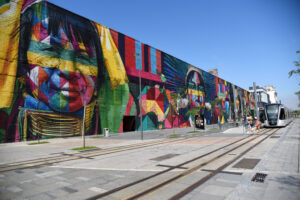
Kobra panels walk
Av. Rodrigues Alves, 241 – Gamboa/Porto Maravilha
The Port area has an ethnicities panel, painted by Graffiti artist Eduardo Kobra coloring the Olympic Boulevard – passing the square until XV Square – the second biggest graffiti of the world by the Guinness World Records, the Book of Records, due to its 2600m2 of extension. The wall is inspired by the Olympic hoops and represents the peace and union among the people portraying five naive faces of the continents that participated in the Games.In its production, 1890 liters of white paint for the base and 2800 spray paint cans during 70 days of work.
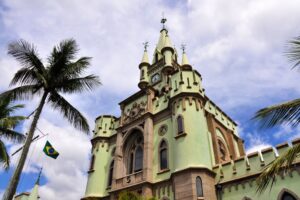
Fiscal Island
Avenida Alfredo Agache, s/n Centro
https://www.marinha.mil.br/dphdm/ilha-fiscal
Scenario of an event that became famous as “ The Last Ball of the Empire”, carried out some days before the Proclamation of the Republic , Fiscal Island has specialized guides following the groups of visitors, and also show all the halls, the Tower and the permanent exhibitions of the space, and give some explanations about the contribution of the Navy to the development of the country.The visit to Fiscal Island is one of the options of entertainment offered by the Navy´s Cultural Space.

Sambadrome
Rua Marquês de Sapucaí, s/n – Centro
http://www.ingressocomdesconto.com.br/
The walkway project of Passarela Professor Darcy Ribeiro – popularly known as Sambódromo of Marquês de Sapucaí( Sambadrome) of Rio de Janeiro or simply Sambadrome, is the project of architect Oscar Niemeyer in 1984. Created to function as an urban equipment for the traditional show of the Samba Parade, in 2021, it was listed by the National Historic and Artistic Heritage, and became integrated to the Archaeological, Ethnographic and Landscaping Tomb Book of IPHAN.
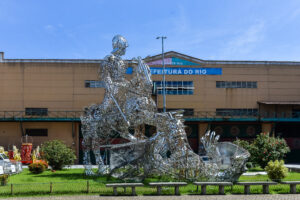
City of Samba
Rua Rivadávia Correia, 60
City of Samba is a complex which gathers the sheds of the Samba Schools of the Special Group. There, the schools produce their costumes and the carnival floats for the parade, besides showing the best of the greatest popular festivity of the planet. Located in Porto Maravilha, each shed has the capacity of assembling the carnival floats, in a total area of 92 thousand square meters, the equivalent of ten football fields. It is literally the nursery of the “ greatest show on Earth”.
Largo do Boticário
Beco do Boticário, 26 – Cosme Velho
The place has an enormous architectural and historic value for the city. besides being in a privileged location, close to other attractions, and it is possible to enjoy and take pictures of the beautiful facades of the Largo, in Cosme Velho, and are listed by the State Institution of Cultural Heritage.And very recently it gained new airs with the Hostel Jo&Joe, serving breakfast, lunch and dinner. In the region, very near, we find the train to the Corcovado, the Institute Casa Roberto Marinho and the Church of Sao Judas Tadeu.

Mureta da Urca
Avenida João Luiz Alves, s/n Urca
Mureta of Urca is a nice place to get together with friends, meet new people and appreciate the stunning sunset with a view to the peak of Sugar Loaf in Guanabara Bay. After sunset, the night starts off busy, with music in the bars nearby and lots of fun. The Mureta is the ideal place for those who seek a more casual place to celebrate the weekend, or even to celebrate a birthday. Urca offers a lot of nightlife, with several bars surrounding it.
Don´t forget to see, live and feel
Here, some of the highlights, known and famous tourist points which are ideal for your visit in the Marvelous City. Places that represent the city by itself and make Rio de Janeiro, an incredible, full of experiences that you will find only here and also rediscover, always with some novelty and a new point to be included. There is only one motto: to enjoy!
Unmissable Beaches
Nature dictates rules in the city. Knowing Rio is to be in touch with nature.And there is nothing better than beginning this journey enjoying the city’s extensive waterfront. Here are some points to be highlighted, but the good thing is to have time to enjoy the tour from Leme to Pontal. Let’s go on this trip together?
Copacabana
It would not be risky to say that it is the most famous beach in the world. But those who think that the strip of sand, the pleasant sea and the iconic wave-shaped sidewalk are the only attributes of the neighborhood are mistaken. The waterfront has lively and diversified kiosks, serve from cold draft beer to refreshing coconut water, caipirinhas, snacks and elaborate meals.Copacabana presents an effervescent nightlife with its bars, and also several gastronomic options and a good shopping center, bringing together famous brands and popular ones.
Ipanema and Arpoador
On the same strip of sand, two gems: Ipanema and Arpoador. The first one, a mandatory point chosen by every tourist. Worldwide famous for the song “ Girl from Ipanema ”, it is one of the greatest attractions of the city, with a good range of bars, restaurants, and artisan fairs, besides an LGBTQIAPN+ stronghold, celebrating the diversity and resistance. On the far left, Arpoador becomes a delightful surfing and cariocas nook seeking tranquility amid the turmoil. When the sun sets on the horizon, there it happens one of the most beautiful shows of Rio, deserving all the applause.
Barra
Very sought after sports lovers due to its good waves and wind, Barra gathers the largest concentration of beaches of Rio de Janeiro. Reserva is located between Barra and Recreio; where it is also possible to dive into the clear waters of Pontal or enjoy the strong waves of Macumba and Prainha.Soon after comes Abricó, the only beach dedicated to the practice of naturism in Rio; besides Grumari, an environment reserve of incomparable beauty. On the way, there is Barra de Guaratiba, with four paradisiacal beaches: Perigoso, Meio, Funda and Inferno.
Prainha
The surfer´s favorite beach, with perfect waves and an indescribable natural beauty. Prainha, as the name itself says, has a small strip of sand 700 meters long with a strong sea protected by hills covered in Atlantic Forest. Located at the end of Recreio Beach,the ideal is to arrive early to enjoy the sun that hides behind the mountains in the afternoon. At the kiosks the most requested are: natural sandwich, juice and açaí.
THE FASCINATION OF AN URBAN FOREST
Floresta da Tijuca
Estrada da Cascatinha, 850 – Alto da Boa Vista
parquenacionaldatijuca.rio
One of the biggest urban forests in the world, this preserved area of Atlantic Forest is very sought by cariocas and tourists for the practice of physical activities, tours and walks. Birds, native plants and fruit trees compose the flora and fauna of Tijuca Forest.Formed by grand mountains, caves, waterfalls and trails that unveil beautiful landscapes, the forest is an example of how nature can live in harmony with the city. We have selected some programs you can make.
Waterfalls and Trails
National Park of Tijuca – Rio de Janeiro
https://parquenacionaldatijuca.rio/locais/
Hidden between forests and mountains, the waterfalls and trails offer a true refuge inside some parks. To enjoy them, just a light walk to assure the right fun. Among the main ones are the following: Cachoeira das Almas, Cachoeiras dos Primatas( both in National Tijuca Park) and Cachoeira do Quebra( located in Sector Serra da Carioca), together with Chuveirão Waterfall and Ducha of Paineiras. Visit the headquarters of National Park of Tijuca and find the one closest to you!
Pedra Bonita
Estrada da Pedra Bonita, – São Conrado
National Park of Tijuca , sector C
https://parquenacionaldatijuca.rio/
The trail of Pedra Bonita is located inside the National Tijuca Park, sector C, precisely between Pedra da Gávea and the districts of São Conrado and Barra da Tijuca. There are steep sections, which can increase physical wear, since part of the route has low vegetation and doesn´t offer natural solar protection. The walk is agreeable and passes through reforestation areas with dense forest. The surprise comes when you reach the summit, providing a stunning view of Pedra da Gávea, the beaches of Barra, São Conrado, Leblon and Ipanema, besides Dois Irmãos Hill, Tijuca Forest and some parts of South Zone.
Chinese View and Mesa do Imperador
National Park of Tijuca – Rio de Janeiro
https://parquenacionaldatijuca.rio/locais/vista-chinesa/
Daily from 8h to 17h
Built at the beginning of XX Century as a tribute to the Chinese people and the import of the tea cultivation in Brazil, the monument offers a large panorama full of green carioca South zone. The trail has easy access and is totally paved, leading to the viewpoint in a steep climb, but it ‘s worth it to admire one of the most beautiful peaks of the city!
Rio de Janeiro, through the cycle roads
Imagine riding a bicycle on the cycle road of Rio de Janeiro, while admiring the unique and special landscapes of the Marvelous City? Thus, the tourist can enjoy the tourist attractions, beaches, besides tours through the urban center in a conscient and accessible way. There are more than 250 km in the West Zone, 130 Km in the South Zone, 50 km in the North Zone and 9 Km in Downtown. From all angles, the pleasure will be immense.



